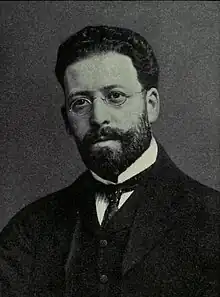Israel Friedlander
Israel Friedlander, also spelled Friedlaender (8 September 1876 – 5 July 1920),[1] was a rabbi, educator, translator, and biblical scholar. Together with Rabbi Mordecai Kaplan, he was a founding adviser to a lecture series that became the Young Israel movement of Modern Orthodox Judaism.

Biography
Friedlander was born in Włodawa, Poland to Pinchas Friedlander, a cattle dealer, and his wife Gittel, who was 16 years old at the time of his birth. He was the eldest of four children.[2] As a boy, he attended cheder in Warsaw. From 1896 to 1900 he attended Berlin University and the Hildesheimer Rabbinical Seminary, where he received his rabbinic ordination. He received his PhD from the University of Strasbourg in 1901.[1]
His first position was as a privatdozent in Semitic languages at the University of Strasbourg from 1902 to 1903. In October 1903 he came to the Jewish Theological Seminary of America as the Sabato Morais Professor of Biblical Literature and Exegesis, a position he held until his death. He also served as a history instructor at the Teacher's Institute of the Seminary.[1]
A translator and Arabist, Friedlander was fluent in Yiddish, Russian, Babylonian and Assyrian.[3] As his command of English was initially poor, he taught in German during his early years at the Jewish Theological Seminary.[4] He authored, edited and translated numerous works.[5]
He married Lilian Ruth Bentwich of London, England, on 26 September 1905. They had three sons and three daughters.[1] With his marriage, Friedlander became the brother-in-law of Norman Bentwich, the first Attorney-General of Mandate Palestine from 1918 to 1931.[6]
Youth movement pioneer
In 1909 Friedlander became the founding president of Young Judaea, an amalgam of several Zionist youth groups. In 1912, together with Rabbi Mordecai Kaplan, a professor of homiletics and philosophy of religion at the Jewish Theological Seminary, he guided young Jewish adults in combating assimilation into secular American society or Reform circles. These efforts resulted in a popular lecture series, which were a predecessor of the Young Israel movement to combat the wave of assimilation by Jews.[7][8]
Friedlander was also active on behalf of the Uptown Talmud Torah, speaking at fundraising events for the New York institution across the region.
Affiliations
Friedlander was the Chairman of the Board of Trustees of the Bureau of Education of the Jewish community in New York.[9] He was part of the Governing Board of the Intercollegiate Menorah Society, the Executive Committee of Bureau of Education of the Jewish Community of New York City and the Executive Committee of the Federation of American Zionists. He was known for his ardent support of Zionism.
Relief missions
In 1918, Friedlander was invited to travel to Mandate Palestine as the Jewish representative of a Red Cross relief mission.[10]
In January 1920, Friedlander traveled to Poland as part of a four-member commission of the American Jewish Joint Distribution Committee to distribute $35 million to starving Jews in Poland and Ukraine. The US State Department gave its permission for the trip, but would not issue passports or afford any protection to the commission members. On July 5, Friedlander and Rabbi Bernard Cantor were murdered by soldiers of the Red Cavalry near Kamenetz-Podolsk, Ukraine.[11]
After her husband's death, Lilian moved her family back to England; two years later, upon the death of her sister who was living in Palestine, she relocated to her sister's home in Zikhron Ya'akov.[6]
Selected bibliography
- Past and Present: A Collection of Jewish Essays (1905)
- The Problem of Judaism in America (1909)
- The Problem of Jewish Education in America, and the Bureau of Education of the Jewish Community of New York City (1913)
- The Present Crisis in American Jewry (1915)
- The Jews of Russia and Poland: A Bird's-Eye View of Their History and Culture (1915)
- Zionism and the World Peace (1919)
References
- "Memorial Meeting: Israel Friedlaender, Bernard Cantor". American Jewish Joint Distribution Committee. 9 September 1920. p. 13.
- Round Shargel, Baila (1985). Practical Dreamer: Israel Friedlaender and the shaping of American Judaism. Jewish Theological Seminary of America. p. 3. ISBN 0-87334-027-2.
- Grafstein, Melech W. (1948). "Sholom Aleichem Panorama". The Jewish Observer: 64.
- Berger, Shlomo; Pomerance, Aubrey; Schatz, Andrea; Schrijver, Emile (2003). Speaking Jewish-Jewish Speak: Multilingualism in Western Ashkenazic Culture. Peeters Publishers. p. 296. ISBN 90-429-1429-7.
- Memorial Meeting, pp. 14–15.
- Glynn, Jennifer (2000). Tidings from Zion: Helen Bentwich's letters from Jerusalem, 1919-1931. I. B. Tauris. p. 48. ISBN 1-86064-349-3.
- Round Shargel, Practical Dreamer, p. 12.
- "Rabbi Mordecai Kaplan (1881-1983)". Jewish Virtual Library. 2011. Retrieved 4 July 2011.
- Memorial Meeting, p. 15.
- Round Shargel, Practical Dreamer, p. 25.
- "Who Murdered Professor Israel Friedlaender and Rabbi Bernard Cantor: The Truth Rediscovered" (PDF). American Jewish Archives Journal. Vol. 55, no. 1. 2003.
Further reading
- Beizer M. Who Murdered Professor Israel Friedlaender and Rabbi Bernard Cantor: The Truth Rediscovered, American Jewish Archives Journal, Vol. 55, # 1, 2003, pp. 63–113. (For the Russian version see: Diaspory, #2 (2005), pp. 176–206.)